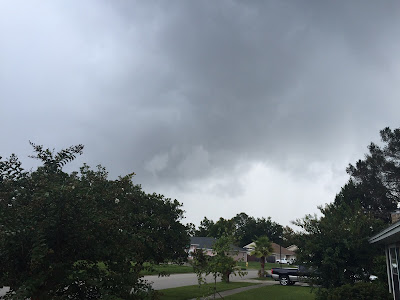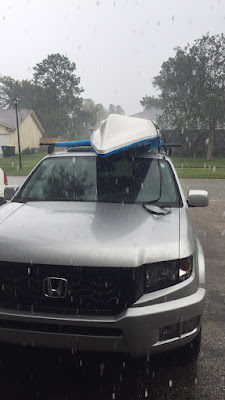"That day I entered into a life of indescribable beauty and delight. There I believe I heard the singing wilderness for the first time"
--- Siguard F. Olson
Outing #7 for us was barely short of a miracle - not the fact the our friends Jim and Jane convinced us that we needed to experience it and that the paddle was within our novice capacities to handle, but in the natural wonder that this three hour self-propelled trip on Florida's Banana River (just south of the Kennedy Space Center) became.
This was our first group paddle. 19 of us in total. It was our first estuarine paddle in water that holds about half the salinity of the nearby Atlantic Ocean as the ocean water mixes with the fresh outflow of our rivers. It was our first paddle of more than an hour and a couple of quiet water miles. It was our first paddle after sundown. But most interestingly, it was our first time witnessing the natural phenomenon of bioluminescence....
Our intrepid group of 19, pre-launch - photo: Helga Lamb
Bioluminescence occurs when, under just the correct conditions, microscopic dinoflagellates in the water "glow" an almost neon blue-green when stirred up by a paddle, the hull of a kayak or other water craft, or a fish rocketing through the water. For the scientifically curious reader, here is a brief explanation of dinoflagellates from UCSD:
CLICK HERE. For those interested in the experience there are a number of outfitters in the area that offer similar tours -- just use your favorite search engine to locate one.
We put in at Kelly Park East on Merritt Island just at sunset and paddled out into the Banana River in waters a bit choppier that Kay and I are used to. Instead of using our small "starter" kayaks, I rented two bigger ones given the length of the trip and my desire to try out a bigger, more serious boat. Kay had a 10' sit-on-top that suited her perfectly and I had a 12' Perception sit-on-top that served me extremely well.
Heading into the Banana River at Sunset. Photo by Jane D.
Florida sunsets are a thing to behold, especially at this time of year (summer) when the sinking sun is often framed and softened by incoming or retreating tropical cumulus clouds. Seeing a sunset from the water on my kayak for the first time was miracle number one for the evening. Being in and on the water gives me the feeling of being an integral part of the natural universe, and that amazing sunset was somehow connected to me -- to all of us on the water that day.
As the sun disappeared below the horizon and the light faded we paddled north, and the small lights on our sterns began to become visible. A tiny armada of tiny mariners in the biggest body of water that Kay and I had yet ventured into. Some in our group were expert long-term kayakers with slick, spear-like fast moving boats, others, like us, were beginners. The rest formed a nice bell curve of the possible experience levels between the extremes -- but we were all connected and all watching out for each other. At dusk the little miracles began to make themselves visible as light translucent blue streams and eddies formed around our paddle blades as we stroked the water.
A cellphone photo I shot as the light faded beyond my bow.
As the light faded entirely on a night with a late moonrise, under the light of the stars we all audibly gasped, oohed and ahed, as we used our paddles to paint patterns in water. Miracle number two. The bioluminescence was now a much deeper and brighter blue as the tiny plankton magicians did their thing. A small pod of dolphin passed us heading south just to our west side. Then suddenly in the shallows we were in the midst of schools of hundreds of mullet. The more experienced, faster paddlers among us chased after these speeding, high jumping fish as dozens of the one- to two-feet long fish sped around my boat the left bioluminescent blue trails behind them, making their own abstract art in the water. Miracle number three.
Then there were the shrieks and laughter and yelps of our group as the jumping fish bounced off of boats, off of paddlers, or in ill-timed leaps of bad luck jumped into our kayaks. I had one leap across my bow. Then felt a punch in my left shoulder as one hit my bare upper arm. A bit later I needed the assistance of one of my fellow paddlers to free a mullet that jumped onto the stern of my kayak and became tangled in the bungies that crisscross the storage well. Yet another first -- a startled fish flopping around in the back of my kayak! The boat I had rented had four scupper holes just in front of my seat. The passage of the kayak over the dinoflagellates made it appear that I had four bright blue LED lights on the floor before me.
The lights of our kayaks reflected on the river -- shot with my iPhone
After paddling several miles north into a preserve restricted to non-motorized craft only we turned back for home. We detoured into the Grand Canal for a few minutes, then back out and under the 528 causeway, leaving our light paintings in our wakes as we went and continued to dodge the leaping mullet. A little over three hours later we landed back at Kelly Park, giddy with the experience that was totally new to many of us. Kay and I both survived the hours and miles extremely well despite bad hips, backs and necks. Along with several friends who were part of our group, our excitement and wonder kept us up until 2:30 a.m. talking about the experience, about the next thing to come, and about how to protect our precious and fragile water resources in a state where our leaders seem not to care. It was amazing. It was a little miracle. I want to do that again. Now.







































